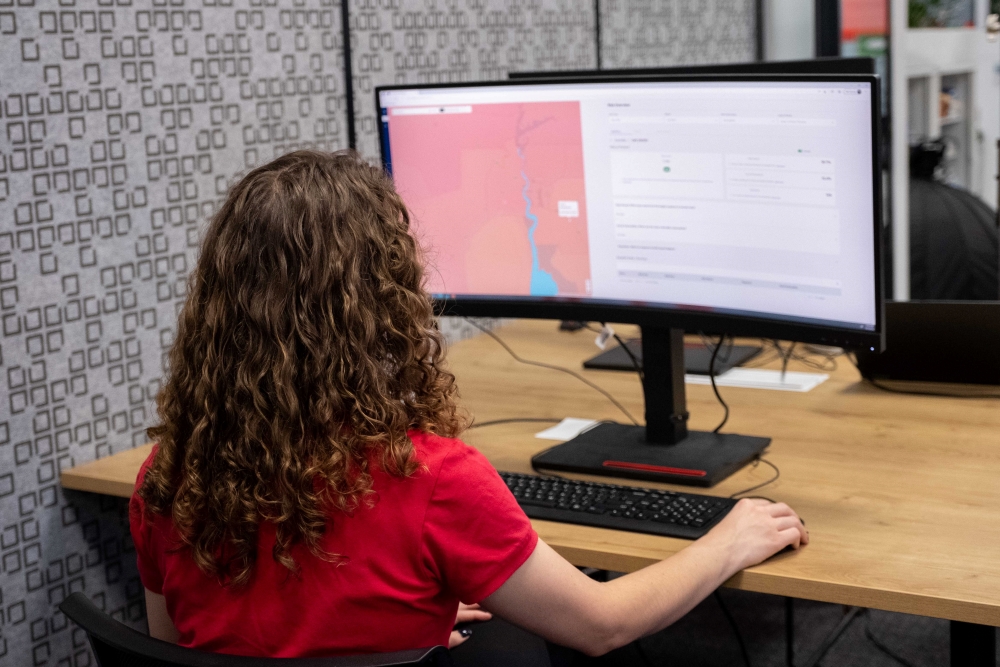Humanity First

Humanity First
|
|
About Humanity First
The Humanity First prototype is being developed to support organisations and individuals working with technology on social and humanitarian challenges. It's designed to investigate the consequences of products or services, address risks, and engage people and communities as decision-makers in the design process. In its current form, the prototype includes a refined list of six principles and further development is underway to bring these principles to life as a part of a practical toolkit.
Humanitech is undertaking this work in collaboration with stakeholders across sectors and communities. This includes the engagement of a multidisciplinary advisory group of subject matter experts, made up of social innovators, people with lived expertise, technology developers, academics and humanitarian practitioners. The prototype integrates components of human-centred design, systems thinking, and participatory community development along with considerations of the Fundamental Principles of the Red Cross and Red Crescent Movement.
Further opportunities for individual or organisational engagement with the Humanity First prototype will be provided both at the upcoming Humanitech Summit, and in the following months as the approach continues to evolve. For more information on how to be involved, see below.
Project goals and rationale
-
We seek to develop a resource for people working with technology on social and humanitarian challenges to support and guide its design, development and implementation. Grounded in humanitarian values and the imperative to ‘Do No Harm’, this resource will ensure technology is developed in ways that are responsible, ethical and inclusive.
-
We are undertaking this work based on an identified gap in existing frameworks tailored to innovation in social and humanitarian contexts, that is driven by humanitarian values and informed by humanitarian practice.
-
The resource must be co-created with stakeholders across sectors and communities.
-
The resource should include clear metrics exist as a part of the resource to determine the impact of a technological solution and whether it is responsible, ethical, and inclusive.

The current version of the prototype
Humanity First is an approach to technological innovation that is grounded in humanitarian values and the humanitarian imperative to Do No Harm.
At the heart of the approach are the Humanity First principles, which take inspiration from good practice in community development and social innovation, alongside considerations of systems and futures perspectives.
Humanity First’s three encompassing themes serve as provocations to all people working with technology to solve social and humanitarian problems: Ensure better futures for all; Centre community; and Move at the speed of trust. These themes amplify the most incisive and resonant ideas of what it takes to pursue responsible, ethical and inclusive innovation.
This work will now build from principles to practice, and consider what tools and guidance might support people working with technology in these contexts to create technology and solutions that promote dignity, safety and trust.
| Principle | Description |
| Build now for the future | Develop products and solutions today based on sustainable business models that have a vision for the future. Include from the beginning considerations of scale, opportunities for long-term community ownership, and/or funding requirements. Ensure solutions include mechanisms for adapting to changing community needs and contexts. |
| Take time to understand the problem | Recognise the complexity of environments and relationships that humanitarian technology innovations are trying to intervene in and allow time to deeply understand the problem the product or technology seeks to solve. Think system-wide, and develop an understanding of the people, networks, cultures, politics, infrastructure and markets in which an innovation may be implemented. |
| Anticipate consequences | Consider the intended and unintended consequences of technology, both in the present and in possible futures. Take steps to understand both social and environmental impacts, and to proactively address these risks. Recognise that all solutions leave a wake. |
| Empower people and communities | Recognise people and communities as experts and decision-makers, and be led by their lived experience. Design for the margins, considering who might be excluded from participation and the social structures or power dynamics that enable this. Ensure access and capabilities for people and communities to meaningfully participate in decision-making, technological design and strategies for their safe use from the outset. |
| Innovate openly and collaboratively | Bring together stakeholders from different sectors, disciplines, and backgrounds in reciprocal partnerships to explore and develop common understandings and strategies around technology products or solutions. Learn from and leverage what others have done in similar contexts or with similar problems. Openly share insights (and capabilities) with others where possible. |
| Safeguard data and privacy | Design technology products with respect for privacy rights and ensure the security of personal data. This is particularly important for people and communities in vulnerable contexts. Ensure all users understand which data is being collected, for what purpose and how it will be maintained/stored. Create clear safeguards for data misuse, breaches or other malicious use cases. |
Previous versions of the prototype
| Principle | Domain/s | Description |
| Do no harm | Guiding principle | Promote dignity, safety and trust in the design, use and regulation of technology. This means scrutinising ethical considerations throughout the lifecycle (by asking the hard questions), testing responsibly (by not experimenting with poorly understood tools on people and communities), and being transparent and realistic about the benefits and harms |
| Empower people and communities | Community as HQ | Recognise people and communities as experts and decision-makers, involving them in the design of technology products and strategies for their safe use from the outset. |
| Bring the right people in the room | Community as HQ | Provide access and build capacity for diverse voices and perspectives - especially those on the margins - to participate in decision-making. |
| Be inclusive | Community as HQ, Be a better ancestor | Ensure technological tools and solutions have broad, societal benefits and that these benefits are accessible to many. |
| Explore and create collectively | Community as HQ, Move at the speed of trust | Bring together stakeholders from different sectors, disciplines, and backgrounds in reciprocal partnerships to explore and develop common understandings and strategies around technology products or solutions. |
| Take time to understand the problem | Move at the speed of trust | Recognise the complexity of environments and relationships that humanitarian technology innovations are trying to intervene in and allow time to develop an understanding of the people, networks, cultures, politics, infrastructure and markets that technology product is targeting. |
| Protect data and privacy | Move at the speed of trust | Design technology products with respect for privacy rights and ensure the security of personal data. This is important for everyone, but especially when working with vulnerable people and communities. |
| Adapt, improve and share | Move at the speed of trust, Be a better ancestor | Learn from what others have done, leverage it, adapt, and share insights (and capabilities) with others. |
| Sustainable for life | Be a better ancestor | Build sustainable products and solutions that can adapt as needs and contexts change. |
| Be alive to consequences | Be a better ancestor | Consider the present, future, intended, unintended, social and ecological impacts of technology products, and take steps to address the risks. |
Australian Red Cross testing ‘Humanity First’ prototype to guide ethical technology development
Technology can help us tackle complex social challenges and empower communities. This prototype seeks to realise this potential by ensuring tools and systems are developed in ways that safeguard people’s rights and dignity.
Over the last year, Humanitech - an initiative of Australian Red Cross - has explored a range of practices and approaches to ethical, responsible, and inclusive innovation. We produced a literature review and a prototype that sets out ‘Humanity First’ principles to guide development of technology so that the benefits are maximised and the risks of doing harm are reduced.
The Humanity First prototype has been created to support organisations and individuals working with technology to investigate the ethical considerations and unintended consequences of their product or service. In its current form, the prototype is made up of nine principles that focus on transparency and privacy, user choice and agency, ethical governance structures, and empowering people and communities to influence the design and decision-making process.
Humanity First principles:
- Maximise good and address harm.
- Understand the individual, social, and environmental context of the problem that the solution is targeting.
- Design with a clear purpose that is shared with stakeholders.
- Be transparent about intentions, capability and use of data and privacy.
- Build relationships with all stakeholders impacted by the technology to inform its design and use.
- Prioritise people and communities at risk of harm within the design and decision-making process and provide the support needed to move at the speed of trust.
- Maximise freedom of those affected to control and use technology.
- Ensure ethical governance of the technology.
- Continually adapt as iterative progress creates the opportunity for greater impact.
Humanitech has developed these principles in collaboration with stakeholders across sectors and communities. This includes social innovators, people with lived experience, technology developers, and humanitarian practitioners. The prototype integrates components of human-centred design, systems thinking, and principles of co-design - along with considerations of ethics, accessibility, and the Fundamental Principles of the Red Cross and Red Crescent Movement.
This first iteration of the Humanity First prototype is now moving through a stage of community and sector consultations and testing, with feedback shaping and refining its design, form, and application. This includes beta testing through the Humanitech innovation lab program, with seven emerging start-ups tackling issues relating to climate change, disasters and emergencies, or equity and justice with the help of data and technology. Additionally, our volunteer Wendy Shang has applied five of the nine Humanity First principles to highlight the issues emerging with the implementation and use of biometric technology.
Further opportunities for individual or organisational input into the Humanity First prototype will be provided through a series of community consultations.
Thank you to those who have provided their insights so far: Gus Portes, Si Qi Wen, Chloe Jones, Today Design, InfoXChange, Centre for Public Impact, City of Melbourne, Monash University Emerging Technologies Research Lab, ADM+S Centre, and Australian Red Cross Emergency Services, Migration Support and Community Programs.
To do this work openly and iteratively, we are also happy to share the working documents and reports that have informed this project to date.
Please get in touch with us for more information and to register your interest.
